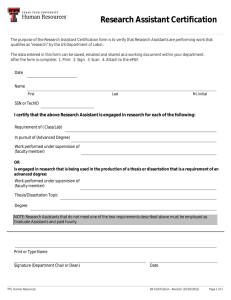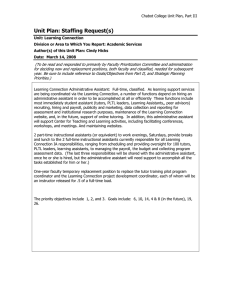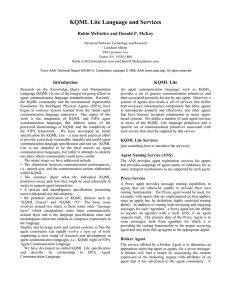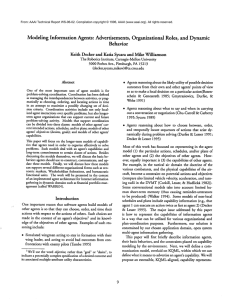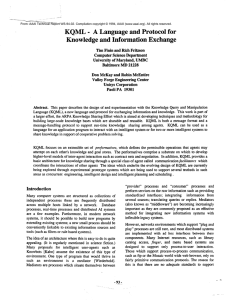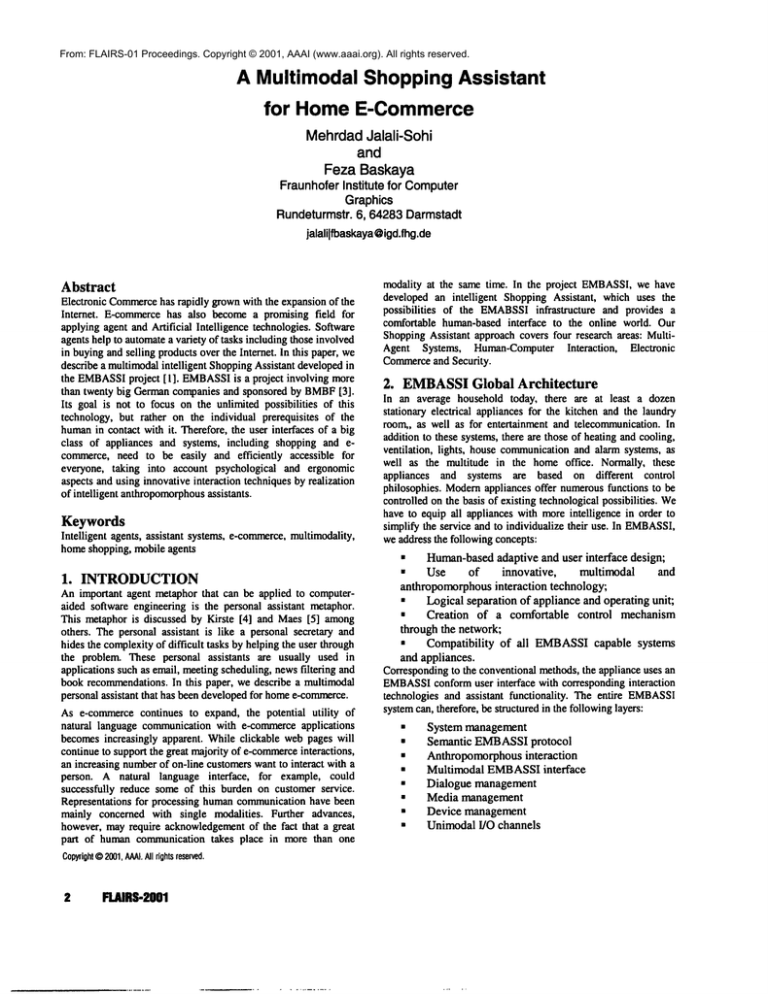
From: FLAIRS-01 Proceedings. Copyright © 2001, AAAI (www.aaai.org). All rights reserved.
A Multimodal ShoppingAssistant
for HomeE-Commerce
Mehrdad
Jalali-Sohi
and
Feza Baskaya
Fraunhofer
Institutefor Computer
Graphics
Rundeturmstr. 6, 64283 Darmstadt
jalalilfbaskaya@igd.fhg.de
Abstract
Electronic Commerce
has rapidly grownwith the expansion of the
Interact. E-commercehas also becomea promising field for
applying agent and Artificial Intelligence technologies. Software
agents help to automatea variety of tasks including those involved
in buyingand selling productsover the Internet. In this paper, we
describe a multimodalintelligent ShoppingAssistant developedin
the EMBASSI
project [1]. EMBASSI
is a project involving more
than twenty big Germancompanies and sponsored by BMBF
[3].
Its goal is not to focus on the unlimited possibilities of this
technology, but rather on the individual prerequisites of the
humanin contact with it. Therefore, the user interfaces of a big
class of appliances and systems, including shopping and ecommerce,need to be easily and efficiently accessible for
everyone, taking into account psychological and ergonomic
aspects and using innovative interaction techniques by realization
of intelligent anthropomorphous
assistants.
Keywords
Intelligent agents, assistant systems, e-commerce,multimodality,
homeshopping, mobile agents
1. INTRODUCTION
An important agent metaphor that can be applied to computeraided software engineering is the personal assistant metaphor.
This metaphor is discussed by Kirste [4] and Maes[5] among
others. The personal assistant is like a personal secretary and
hides the complexityof difficult tasks by helping the user through
the problem. These personal assistants are usually used in
applications such as email, meetingscheduling, newsfiltering and
book recommendations.In this paper, we describe a multimodal
personal assistant that has been developedfor homee-commerce.
As e-commercecontinues to expand, the potential utility of
natural language communicationwith e-commerceapplications
becomesincreasingly apparent. While clickable web pages will
continue to support the great majority of e-commerce
interactions,
an increasing numberof on-line customerswant to interact with a
person. A natural language interface, for example, could
successfully reduce someof this burden on customer service.
Representations for processing humancommunicationhave been
mainly concerned with single modalities. Further advances,
however, mayrequire acknowledgementof the fact that a great
part of humancommunication takes place in more than one
Copyright
©2001,
AAAI.
Allrightsreserved.
2
FLAIRS-2001
modality at the same time. In the project EMBASSI,
we have
developed an intelligent Shopping Assistant, which uses the
possibilities of the EMABSSI
infrastructure and provides a
comfortable human-basedinterface to the online world. Our
ShoppingAssistant approach covers four research areas: MultiAgent Systems, Human-Computer Interaction,
Electronic
Commerceand Security.
2. EMBASSI
Global Architecture
In an average household today, there are at least a dozen
stationary electrical appliances for the kitchen and the laundry
room,, as well as for entertainment and telecommunication. In
addition to these systems, there are those of heating and cooling,
ventilation, lights, house communicationand alarm systems, as
well as the multitude in the homeoffice. Normally, these
appliances and systems are based on different control
philosophies. Modem
appliances offer numerousfunctions to be
controlled on the basis of existing technological possibilities. We
have to equip all appliances with more intelligence in order to
simplify the service and to individualize their use. In EMBASSI,
we address the following concepts:
¯
Human-basedadaptive and user interface design;
¯ Use of innovative,
multimodal
and
anthropomorphous interaction technology;
¯ Logical separation of appliance and operating unit;
¯ Creation of a comfortable
control
mechanism
through the network;
¯ Compatibility
of all EMBASSIcapable systems
and appliances.
Correspondingto the conventional methods,the appliance uses an
EMBASSI
conformuser interface with corresponding interaction
technologies and assistant functionality. The entire EMBASSI
systemcan, therefore, be structured in the followinglayers:
¯
System management
¯
Semantic EMBASSIprotocol
¯
Anthropomorphous interaction
¯
Multimodal EMBASSIinterface
¯
Dialogue management
¯
Media management
¯
Device management
¯
Unimodal I/O channels
SeI1SOF
Protocol
Pr~oc~
(Capabilities,
...)
Figure I :EMBASSI
global architecture
Differentlayers, fromtop to bottom,forma generic framework,
in
whichthe desired user interface can be configuredby selection
froma" modularkit" of innovativeinterfaces (see Figure1 ).
The following fundamental aspects belong to the generic
framework:
¯
Network techniques
¯ Distributed applications and operating systems
¯ Security aspects
¯ Online and remote configurability of appliances
¯ System management
The system managementis the highest level of the EMBASSI
system.Thefunctionality of the systemmanagement
is distributed
andscalable. Thesystemmanagement
is responsiblefor:
¯ the recording, storage and administration of user
and appliance profiles;
¯ the communication
between
EMBASSI
compatible appliances;
¯ the location of data and services.
3. Semantic EMBASSI
Protocol
Thecommunication
betweenthe multimodalinterface or assistant
and the appliance is managedover the semantic EMBASSI
protocol. This is a mixedprotocol composedof KQML
wrapper
and XML
content. All assistants in EMBASSI
communicateover
this protocol.
3.1
KQML
The KnowledgeQuery and Manipulation Language(KQML)[2]
is a high-level language intended to support interoperability
amongintelligent agents in distributed applications. It is both a
messageformat and a message-handlingprotocol to support runtime knowledgesharing amongagents. KQML
is an interlingua, a
languagethat allows an application programto interact with an
intelligent system. It can also be used for sharing knowledge
amongmultiple intelligent systems engaged in cooperative
problemsolving. This language,originally developedas part of a
DARPA
KnowledgeSharing initiative, is becominga de facto
standard for inter agent communicationlanguages. A KQML
messageconsists of a performative, the content of the message,
and a set of optional arguments.Theperformativespecifies an
assertion or a query used for examiningor changinga Virtual
KnowledgeBase (VKB)in the remote agent.
3.2 XML(Extensible
Markup Language)
XML,the Extensible MarkupLanguage,is a newformat designed
to bring structured informationto the Web.It is a languagefor
electronic data interchange in the Web. XMLis an open
technology standard of the WorldWideWebConsortium(W3C),
the standards group responsible for maintainingand advancing
AI & ELECTRONIC
COMMERCE 3
I
MailerAgent
4
I
i~MBASSI
AssJsts, ut
Remote
EMBASSI
Figure2: All EMBASSI
Assistants communicateover KQML
HTML
and other Web-related standards. In EMBASSI,
we use
the XMLin the content of the KQMLmessage exchanged
between the agents. Below, we give an example of such a
message.In this message,the DialogueManagerorders a western
videooverthe shoppingassistant:
Dialogue Manager--) Shopping Assistant (searchForContent
(ContentInfoci, Conditionsco)
(stream_all
:sender DialogueManager
:receiver SHOPPING
A
:reply-withid2
4. Multimodal EMBASSIInterface
:ontology agent_ontology
:language XML
4.1 Dialogue Management
:content(
<searchForContent>
<ContentInfo>
<ContentType> Video </ContentType>
<Genre>Western </Genre>
</Contentlnfo>
</SearchForContent>))
All EMBASSI
assistants exchange messages over the EMBASSI
protocol using a KQML
router (see Figure 2). In the EMBASSI
context, wehave developeda secure mailer agent, whichhelps
EMBASS[
assistants to communicate over the Internet and
KQML
router. This architecture overcomes the problem of
traditional KQML
routers being unable to communicate
over the
Internet (see Figure2).
4
FLAIRS-2001
A malt/medalinterface is capable of using several unimodal//O
channels simultaneously to get higher information intensity
transferred. A classic exampleon the input side is the combination
of voice input andgesturerecognition:the user pointsto an object
on the computerscreen and says "close it". Thecombinationof
graphics and language is an examplefor the output side. An
exampleof this is user identification througha combinationof
languageanalysis and face recognition. Themultimodalinterface
in EMBASSSI
consists of three hierarchical management
layers
that steer the process of the interaction betweenhumanand
applianceon the technologyside andI/O channels(see Figure1).
Thedialogue management
is the highest management
layer of the
multimodal interface. The dialogue managementmediates
betweenusers and application. Therefore, it must have all
necessarycontext informationconcerningthem. Theuser profile,
the appliance or application profile, I/O channel for the
interaction and the situation are all part of the context
information. Onthe basis of this data madeavailable by the
system management,a dialogue is shaped between users and
application by the intercession of the EMBASSI
interface and
handledover existing I/O channels.
4,2 Media Management
A piece of informationis set aside in such a formthat it can be
portrayed by a mediamanagerand dialogue manager,situationdependenton different mediaor devices. Thus,it is possiblethat a
certain dialogue is established on the TVscreen over an
anthropomorphous
conversationwith an Avatar or displayed over
a text messageon the computerscreen, it is crucial that a
universalmentalmodelof the type of conversationexists in order
to avoid a break betweendifferent interaction types during
communication.
4.3 Device Management
The device management
is the abstract layer betweenthe media
managementand the different I/O channels. The device
management
communicates
directly using a specific device driver
over a networklayer with the physical I/O devices. The device
management
allows a flexible binding of different I/O devicesand
offers layers for logical access to them, independentof the
physicalpropertiesof individualdevices.
5. Unimodal Input Technologies
The term ’unimodalinput technologies’ either includes a number
of different technologies fromthe direct input of information
throughthe user or fromthe extraction of informationabout the
user, aboutthe conditionor the situation of the user, as well as of
other context-relevant data. Classic input technologies like
keyboardor mouseare also taken into account in the overall
concept,since they are still importantfor certain applicationsand
user groups. Thefollowingtechnologies havebeen developedand
adapted to the EMBASSI
frameworkand the typical EMBASSI
applications:
¯
Video-based input forms
¯
Gesture recognition
¯
Facial expression and emotion recognition
¯
Lip reading
¯
Eye tracking
¯
Pointer device
¯
Sensors for the recognition of the position
6. Unimodal Output Technologies
Amongothers. EMBASSI
supports the user with the following
output technologies:
¯
Audio output unit
¯
Avatar
6.1 Audio Output Unit
The audio output unit is an important component of the
anthropomorphous
interaction and consequentlyan object of the
performances in EMBASSI.
Another important feature is the
intercession of the urgencyof a piece of informationby meansof
particular languageemphasis.
6.2 "Avatar" and "User Interface Agent"
In the context of User Interface Agent, EMBASSI
aims at the
embodimentof an artificial, autonomousand anthropomorphous
software agent. This necessitates a corresponding dialogue
formation as componentof the user-interface designs. For this
entity, we use - in the EMBASSI
context - the term "Avatar"[11].
This is the anthropomorphous
representation of an autonomous
and proactive entity that adopts the dialogue with the user.
"Avatars"are mostlypresented in a synthetic three-dimensional
face (see Figurel). This results in a communication
in the form
a natural, human-based
dialogue.
6.3 ShoppingAssistant
In the context of the EMBASSI
project, we are workingon the
development of a homeshopping scenario. The technology
developedin EMBASSI
is available for every componentplugged
to the systemin a very simplemanner.Theshoppingassistant is
responsible for providing all users at homewith all kinds of
informationand content (video, audio, etc.) fromthe Internet.
Below,wedescribe a shoppingscenario in whichthe user tries to
ordera video. Entities involvedin the scenarioarc:
¯ Shopping Assistant: This is the central entity
responsible for all kinds of information retrieval tasks
on the Internet. This assistant managesall e-commercerelevant tasks such as:
Payment
Certification request
Authenticationagainst commercialservers
Authorizationof different users for special orders
on the Internet (child protection mechanism)
¯ User Assistant: The User Assistant is responsible
for recording and managingprofiles for all registered
users.
¯
Context Manager: The Context Manager is aware
of all situation-dependent questions. This includes the
situation of:
Users at home
Devices
Assistants
Sensors
¯ Generic Dialogue Manager (GDM): controls all
parallel modalities in a dialoguewith the user.
¯ Database Assistant:
is responsible
for the
management
of all content storage and retrieval tasks in
EMBASSIat home. This assistant is equipped with
access control mechanisms.
hup.,raiI. RMI
,~J
!
EMBASSI
Aud’.m~V"
ShoppingTABistant
SeMoA ~//
Figure3: ShoppingScenario
Internet
AI & ELECTRONIC
COMMERCE 6
¯ Mobile agent server
SeMoA: The Shopping
Assistant maydecide to send a mobile agent to perform
the information retrieval tasks in order to minimizethe
communication
costs of the transaction. In this case, the
Shopping Assistant configures a SeMoA[9,10] agent
and dispatches it to the agent server of the providers.
SeMoA is a secure agent server developed by
Fraunhofer-IGD focusing on the security requirements
of mobile agent technology. The architecture of SeMoA
is published mainly in [10]. After performingthe tasks,
the agent will return to EMBASSI
and give the results
to the ShoppingAssistant. The second application with
a mobile agent is the remote configuration of the
EMBASSI
devices from outside. We will publish this
scenario in a separate paper in the near future.
7. Shopping Scenario
TheUser expressesthe general wish: " I wantto watcha video".
Theinstalled microphonecaptures this wish and produces an
audio signal. A device managerspecific for the microphone
unit
producesa KQML
messagefrom the input signal and sends it to
the generic dialogue manager.Receivingthis KQML
message,the
EMBASSI
dialogue managersearches inside his knowledgebase
andfinds out whichfunction of registered assistants couldmatch
this wish. In this ease, the GDM
(Generic Dialogue Manager)
finds the function "searchForContent"as appropriate and sends
the search task "searchForContent"inside a KQML
messageto
the ShoppingAssistant. TheShoppingAssistant asks the context
managerwhichuser is logged in. Thecontext managerchecksthe
actual situation using installed sensorsandgives the UserIDof the
active user to the Shopping Assistant. For our first
implementation,weuse a finger print sensor, whichis installed
inside the remoteControl Unit of the television. TheShopping
Assistant nowasks the UserAssistant whichgenre this user may
prefer. Theuserassistant givesa list of genresfor this user to the
shoppingassistant as a response.TheShoppingAssistant locates
the desired contents on the Intemet and notifies the GDM
about
themas an answer to the user’s inquiry. The GDM
presents the
results over different modalitiesbasedon the user profile andthe
situation and asks the user to choosea content. Thevideocan now
be orderedby the online providerusing a digital certificate of the
user. The GDM
orders the video by calling the "orderContent"
function of the shoppingassistant over a KQML
message.
8. Related Work
Theidea of intelligent agents evolvedin the 1970’s.A numberof
research organizations and companiesare workingon agents with
a focus on different problematicsof this topic. As e-commerce
continued to expand, numerousinstitutes began to work on
intelligent assistants for e-commerce
applications. Jango[6],
developedby Netbot,Inc., foundedin May1996,is an application
for Windows95
or WindowsNT
that worksin browsers (Microsoft
Internet Exploreror NetscapeNavigator).A user enters the name
of a producthe is looking for and Jangoautomaticallydetermines
which stores and information sites are relevant. Jango
communicates
with online stores using standard Webprotocols
and workswith existing interfaces of online stores. Tete-a-Tete
(T@T)[7] is a project within MITMediaLab’s Agent-mediated
6
FLAIRS-2001
Electronic Commerce(AmEC)Initiative.
T@T’sapproach
engages consumer-ownedshopping agents and merchant-owned
sales agents in integrative negotiations. Mindmaker’s
Intelligent
PersonalAssistant "ProdyParrot" [8] uses interactive multimedia
to interact withthe user. Prodytalks andinteracts withthe user as
an Intelligent Assistant for the PC, in the form of an animated
avatar on the desktop.
9. Conclusions and Future Work
Technologydeveloped in EMBASSI
will be available in a few
years to consumers
all overthe world.A veryimportantissue that
weare workingon is that of Integrity and the confidentiality of
the user’s personal data, even at home.Anintegrated security
architecture is requiredto secureheterogeneous
agent systemsfor
the sensitive applications described above. This architecture
should protect against the threats of open networksand inside
attacks while keeping maximum
operational freedomfor agents,
whichis fundamentalfor the actual marketexploitation of this
technology.
10.
ACKNOWLEDGMENTS
Thework described is being done during the EMBASSI
project.
EMBASSI
is sponsored by BMBF[3], GermanMinistry for
Education and Research. Wewould like to thank our head of
department,Dr. ChristophBusch,for his support during our work
to developthe applicationoutlinedin this paper.
11.
REFERENCES
[1] EMBASSI
(Elektronische MultimedialeBedien- und ServiceAssistenz), http://www.embassi.de
[2] TimFinin, Yannis Labrouand James Mayfield, KQML
as an
agent communication
language,in Jeff Bradshaw
(Ed.), "Software
Agents", MITPress, Cambridge1997
[3] German Ministry for Education and Research
http://www.bmbf.de
/
[4] EstebanCh,’ivez, Rtidiger Ide andThomas
Kirste, Interactive
applicationsof personalsituation-awareassistants, Computers
and
Graphics23(6) (1999) pp. 903-915
[5] Pattie Mates, Agents that reduce work and information
overload, Communications
of the ACM,
37(7), July 1994
[6] Jango Homepage:http://www.jango.com
[7] tete-a-tete, http://ecommerce.media.mit.edu/tete-a-tete/
[8] Mindmaker,http://www.mindmaker.co
[9] Secure Mobile Agents Project, Fraunhofer Institute for
ComputerGraphics, Germany
bttp:llwww.igd.fhg.deligdaSIprojectslsemoalsemoa_de.html
[10] VolkerRoth and MehrdadJalali, Conceptsand Architecture
of a Security-centric MobileAgentServer, Fifth International
Symposiumon AutonomousDecentralized Systems, March2628, 2001Dallas, Texas,U.S.A
[ 11 ] AlfredoPina, EvaCerezoand FranciscoJ. Ser6n, Computer
animation:fromavatars to unrestricted autonomous
actors (A
survey on replication and modellingmechanisms),Computersand
Graphics24(2) (2000)pp. 297-311




